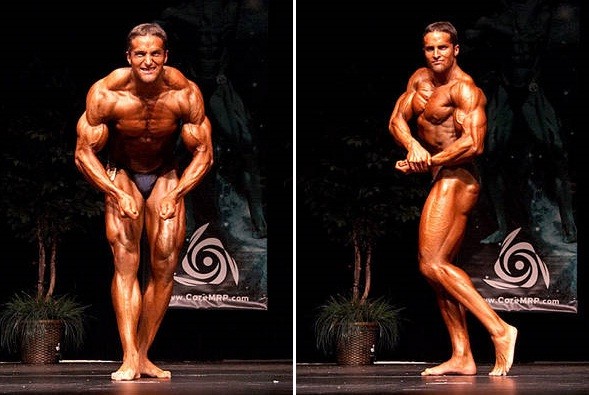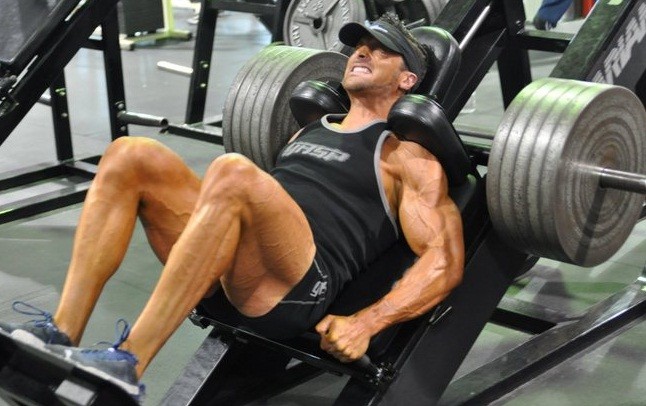Level: advanced
Days per week: five
Training type: split
Purpose: get stronger, muscle definition
32 exercises:
- 17 multi-joint exercises
- 15 isolation exercises
Introduction
The PHAT: Power Hypertrophy Adaptive Training program combines training principles of bodybuilders and weightlifters. It is well known that if you need to build muscle mass, you need to train according to the classic bodybuilding scheme which is; low weight + high reps. At the same time, it is difficult to imagine a person with skinny legs who could squat with a 200-kg barbell. The PHAT program is built according to the classic powerlifting scheme high weight + low reps. This approach not only won’t prevent you from building muscle mass, but it will help you achieve this.
A similar principle is used by another hypertrophy training program – Power Hypertrophy Upper Lower (PHUL), but, unlike the latter, PHAT is recommended for more trained fitness adepts.
PHAT is more of a set of principles than a clear program. The program presented here is just an example of how you can create your own training plan.
About the Creator
PHAT: Power Hypertrophy Adaptive Training was created by Layne Norton – a professional natural bodybuilder who has a BS in biochemistry and a Ph. D in nutritional sciences, a fitness trainer with NGA and IFPA certificates.
He has put everything he has learned together in the PHAT Workout that works great for getting shredded, combining the strength progression of a bodybuilder and powerlifter all-in-one.

Who is the PHAT Workout Program for?
For experienced athletes ready for advanced training. The program contains many exercises, some of which, frankly, are exotic. PHAT will delight those who are tired of the standard sets of exercises.
PHAT Workout Program Overview
As already mentioned, PHAT can be implemented in a dozen variations. But all of them will be based on the same principles.
Each muscle group is targeted twice a week. The first two days are split into upper and lower body power days, followed by a day of rest. Then there are three days of classic bodybuilding split training.
An example of the PHAT would be:
- Day 1: Upper Body Strength Training
- Day 2: Lower Body Strength Training
- Day 3: Rest
- Day 4: Hypertrophy Workout – Back and Shoulders
- Day 5: Hypertrophy Workout – Legs
- Day 6: Hypertrophy Training – Chest and Arms
- Day 7: Rest
Strength Days
The first two days are based on the big multi-joint exercises such as; squats and deadlifts for the lower body, bench presses, weighted pull-ups for the upper body. On these days, work according to a scheme 3-5 sets, 3-5 reps. Use only one power exercise for lower body, presses, and pulls and rows, i.e. don’t do squats and front squats in the same workout.
Rest between sets as much as necessary to recover and be ready for the next set, if you need 5-6 minutes, so be it. Save short rests for the hypertrophy days; on power days, your goal is to do the sets with the heaviest possible weights. To make consistent progress, change the power exercise every 2-3 weeks. Add a few sets of assistance exercises for smaller muscle groups such as calves, shoulders and arms.
Hypertrophy Days
On hypertrophy days, do 6-8 sets of 3 speed reps with 65-70% of your 3-5 rep max to start your workout with the power exercise you used earlier in the week.
For example, in low strength training, you squat with a 150 kg bar for 3 sets of 5 reps. This means that on the hypertrophy day, you will need to squat with a 100 kg barbell for 6 sets of 3 reps. The reps should be explosive, in high-speed mode, try to perform the eccentric part of the movement (lifting) as quickly as possible, with the correct technique. For the reps to be explosive, do not take too much weight. Rest no more than 90 seconds between reps.
After the high-speed reps, hypertrophy day looks pretty much the same as any classic hypertrophy training program. Sets consist of 8-20 repetitions with 1-2-minute rest. The volume of these sessions should be 50-70% higher than that on power days.
Don’t overuse repetitions to failure. The author recommends going to failure only in the last or the last two sets, and in the rest always stop 1-2 reps shy of failure. In the first 2-4 weeks of PHAT training, DO NOT train to failure at all. This can lead to depletion of the central nervous system, disrupt reparative processes.

Overtraining
The first few weeks on the program can be difficult: you can feel constant fatigue, weakness. According to the author, after 4-6 weeks of regular exercise, the body adapts and the general well-being improves.
However, we recommend deloading every 6-12 weeks of the program. A deload would consist of 1-3 weeks of lifting at 60-70% of your normal weight potential. This will be enough to maintain your strength, but light enough to allow you to actively recover.
PHAT Workout Program Routine
Day 1: Upper Body Strength Training
| An exercise | Sets | Reps |
|---|---|---|
| Pulling Power Movement: Bent over or Pendlay rows | 3 | 3-5 |
| Assistance Pulling movement: Weighted Pull-ups | 2 | 6-10 |
| Auxiliary Pulling movement: Rack chins | 2 | 6-10 |
| Pressing Power Movement: Flat dumbbell press | 3 | 3-5 |
| Assistance pressing movement: Weighted dips | 2 | 6-10 |
| Assistance pressing movement: Seated dumbbell shoulder presses | 3 | 6-10 |
| Auxiliary curling movement: Cambered bar curls | 3 | 6-10 |
| Auxiliary extension movement: Skull crushers | 3 | 6-10 |
Day 2: Lower Body Strength Training
| An exercise | Sets | Reps |
|---|---|---|
| Pressing Power Movement: Squats | 3 | 3-5 |
| Assistance pressing movement: Hack Squats | 2 | 6-10 |
| Assistance extension movement: Leg extensions | 2 | 6-10 |
| Assistance pulling movement: Stiff legged deadlifts | 3 | 5-8 |
| Assistance pulling/curling movement: Glute ham raises or lying leg curls | 2 | 6-10 |
| Auxiliary calf exercise: Standing calf raise | 3 | 6-10 |
| Auxiliary calf exercise: Seated Calf Raise | 2 | 6-10 |
Day 3: Rest
Day 4: Back and Shoulders Hypertrophy
| An exercise | Sets | Reps |
|---|---|---|
| Pulling Power Exercise speed work: Bent over or Pendlay rows | 6 | 3 |
| Hypertrophy pulling movement: Rack chins | 3 | 8-12 |
| Back Hypertrophy: Seated cable row | 3 | 8-12 |
| Back Hypertrophy: Dumbbell rows or shrugs bracing upper body | 2 | 12-15 |
| Back Hypertrophy: Close grip pulldowns | 2 | 15-20 |
| Shoulders Hypertrophy: Seated Overhead Press | 3 | 8-12 |
| Shoulders Hypertrophy: Upright rows | 2 | 12-15 |
| Shoulders Hypertrophy: Side lateral raises with dumbbells or cables | 3 | 12-20 |
Day 5: Lower Body Hypertrophy
| An exercise | Sets | Reps |
|---|---|---|
| Lower Body Power Exercise speed work: Squats | 6 | 3 |
| Hypertrophy pressing movement: Hack squats | 3 | 8-12 |
| Hypertrophy pressing movement: Leg press | 2 | 12-15 |
| Hypertrophy extension movement: Leg extensions | 3 | 15-20 |
| Hypertrophy pulling movement: Romanian deadlifts | 3 | 8-12 |
| Hypertrophy curling movement: Lying leg curls | 2 | 12-15 |
| Hypertrophy curling movement: Seated leg curls | 2 | 15-20 |
| Hypertrophy calf movement: Donkey calf raises | 4 | 10-15 |
| Hypertrophy calf movement: Seated calf raises | 3 | 15-20 |
Day 6: Chest and Arms Hypertrophy
| An exercise | Sets | Reps |
|---|---|---|
| Pressing Power Exercise speed work: Flat dumbbell presses | 6 | 3 |
| Hypertrophy pressing movement: Incline dumbbell presses | 3 | 8-12 |
| Hypertrophy pressing movement: Hammer strength chest press | 3 | 12-15 |
| Hypertrophy fly movement: Incline cable flyes | 2 | 15-20 |
| Hypertrophy curling exercise: Cambered bar preacher curls | 3 | 8-12 |
| Hypertrophy curling exercise: Dumbbell concentration curls | 2 | 12-15 |
| Hypertrophy curling exercise: Spider curls bracing upper body against an incline bench | 2 | 15-20 |
| Hypertrophy extension exercise: Seated tricep extension with cambered bar | 3 | 8-12 |
| Hypertrophy extension exercise: Cable pressdowns with rope attachment | 2 | 12-15 |
| Hypertrophy extension exercise: Cable kickbacks | 2 | 15-20 |
Day 7: Rest
If you reached a plateau in a certain muscle group, we recommend to change auxiliary exercises. That is, if you, for example, reached a plateau in the bench press, add auxiliary movements on the triceps (push-ups on the uneven bars or French press). If changing exercises and focusing on weak portions of the lifts themselves don’t improve things, or you simply feel deadly tired, then it is time to take 1-3 weeks of deloading. For a deload we recommend doing your normal routine, but only using 60-70% of normal weights.


